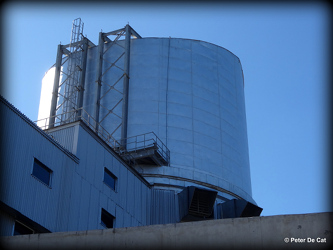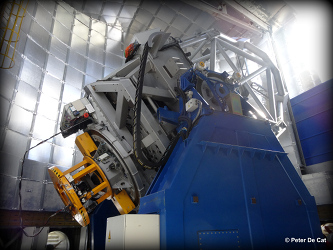The Belgo-Indian Network for Astronomy and Astrophysics (BINA)
The Devasthal observatory is a new astronomical site in India, located at a high altitude of 2450 meters in the Kumaun region of Himalayas in the district Nainital in the state Uttarakhand. It is operated by the Aryabhatta Research Institute of Observational Sciences (ARIES; Nainital, India) and currently hosts three telescopes: a 1.3-m opt ical telescope and two so-called Indo-Belgian telescopes. The 3.6-m Devathal Optical Telescope (DOT; Fig. 1, left and middle) has received this status because it has been constructed by AMOS (Advanced Mechanical and Optical Systems; Liège, Belgium) with financial support of 2,000,000 € from the Belgian Federal Science Policy Office (BELSPO; Govt. of Belgium). In return for the financial aid, 7% of the telescope time with the DOT is reserved for projects lead by Belgian astronomers. The 4-m International Liquid Mirror Telescope (ILMT; Fig. 1, right) is a Belgian initiative lead by members of the University of Liège in collaboration with institutes in India (ARIES; Nainital) and Canada (Québec, Montréal, Toronto, Vancouver, and Victoria).
The "Belgo-Indian Network for Astronomy and Astrophysics" (BINA) was created to increase the interaction between Indian and Belgian astronomers and to stimulate the common use of the Indo-Belgian telescopes and other telescopes of interest (Table 1) to maximize their scientific output for solar system, galactic and extragalactic celestial objects. The proposal for this bilateral project was submitted in 2014 by P. De Cat (Belgian PI; Royal Observatory of Belgium, Brussels, Belgium) and S. Joshi (Indian PI; Aryabhatta Research Institute of Observational Sciences, Nainital, India). It has been approved in 2016 by the International Division, Department of Science and Technology (DST, Govt. of India) and BELSPO. The network that emerged from this collaboration is still expanding and currently involves colleagues from six Belgian and twelve Indian institutes (Table 2).
BINA provides funding both to organize workshops in India or Belgium and to enable work visits of typically two weeks of Indian scientists/technicians to Belgian partner institutes and vice versa. These workshops are ideal to present scientific results of Indo-Belgian projects and to allow face-to-face discussions to strengthen on-going collaborations and/or to initiate new ones. The work visits can be used to discuss scientific and instrumentation projects for the new observing facilities at Devasthal observatory.
The first official BINA activity was the 1st BINA workshop. It was held from 15-18 November 2016 at the Uttarakhand Academy of Administration (UAoA, ATI) in Mallital Nainital (India). The organization was lead by S. Joshi (ARIES, India). In total, 107 astronomers from 8 different countries (#88 from India, #10 from Belgium, #3 from Thailand, #2 from Japan, #1 from China, #1 from Russia, #1 from South Africa, and #1 from Taiwan; Figure 2) attended this international workshop. The focus of this workshop was on the "Instrumentation and Science with the 3.6-m DOT and 4-m ILMT telescopes". Given that this was the first event where all the Indian and Belgian partners could meet in person, the aim was to give an overview of the current and future possibilities to base scientific projects on data obtained with the Indo-Belgian telescopes and/or other astronomical facilities in India. Furthermore, members of each partner institute have been given the opportunity to highlight their main scientific topics to stimulate collaborations with each other and international collaborators. The proceedings have been published in the Bulletin de la Société Royale des Sciences de Liège (volume 87, Actes de colloques).
| location | operated by | instruments | |
| DOT @ ARIES 3.6-m Devasthal Optical Telescope |
Devasthal observatory (Devasthal, India) |
Aryabhatta Research Institute of Observational Sciences (Nainital, India) |
optical and near-infrared imaging, narrowband and broadband photometry, low-resolution spectroscopy |
| ILMT @ ARIES 4-m International Liquid Mirror Telescope |
Devasthal observatory (Devasthal, India) |
Aryabhatta Research Institute of Observational Sciences (Nainital, India) |
CCD direct imaging |
| 1.04m @ ARIES 1.04-m ARIES telescope |
ARIES observatory (Nainital, India) |
Aryabhatta Research Institute of Observational Sciences (Nainital, India) |
CCD & polarimeter |
| 1.3m @ ARIES 1.3-m Robotic Telescope |
Devasthal observatory (Devasthal, India) |
Aryabhatta Research Institute of Observational Sciences (Nainital, India) |
multi-colour photometry |
| 2.01m @ HCT 2.01-m Himalayan Chandra Telescope |
Indian Astronomical Observatory (Leh, Ladakh, India) |
Indian Institute of Astrophysics (Bangalore, India) |
Himalaya faint object spectrograph, near-IR imager & optical CCD imager |
| 1.2m @ PRL 1.2-m Infrared Telescope |
Mount Abu Observatory (Rajasthan, India) |
Physical Research Laboratory (Ahmedabad, India) |
NICMOS Infrared Camera and Spectrograph, Imaging Fabry-Perot Spectrometer, high time resolution IR Photometer, Optical Polarimeter, Fibre-linked Grating Spectrograph high resolution optical spectrometer 'PRL Advanced Radial-velocity All-sky Search' |
| GMRT @ NCRA-TIFR Giant Metrewave Radio Telescope |
GMRT Observatory (Khodad, India) |
National Center for Radio Astrophysics (Pune, India) Tata Institute of Fundamental Research (Mumbai, India) |
30 parabolic 45-m dishes spread over up to 25 km for radio interferometry |
| 1.2m @ RMO 1.2-m Mercator telescope |
Roque de los Muchachos Observatory (La Palma, Canary Islands, Spain) |
KU Leuven (Leuven, Belgium) |
HERMES (high-resolution spectroscopy) MAIA (3-channel fast photometer) |
| 6.0m @ SAO 6.0-m Большой Телескоп Альтазимутальный (BTA) |
Special Astrophysical Observatory (Zelenchuksky District, Russia) |
main stellar spectrograph, nasmyth échelle spectrometer, digital speckle interferometer, spectral camera with optical reducer for photometric and interferometric observations, multi-mode spectrograph & multicolor panoramic photometer-polarimeter |
|
| SAAO South African Astronomical Observatory |
Sutherland (South Africa) |
||
| all @ ESO all telescopes of the European Southern Observatory |
La Silla Observatory (Chile) Paranal Observatory (Chile) Llano de Chajnantor Observatory (Chile) |
European Southern Observatory (Garching, Germany) |
| ROB | Royal Observatory of Belgium, Brussels, Belgium (P. De Cat) |
| KU Leuven | Katholieke Universiteit Leuven, Leuven, Belgium (K. Kolenberg) |
| UAntwerpen | Universiteit Antwerpen, Antwerp, Belgium (K. Kolenberg) |
| UGent | Universiteit Gent, Ghent, Belgium (M. Baes) |
| ULB | Université Libre de Bruxelles, Brussels, Belgium (A. Jorissen) |
| ULiège | Université de Liège, Liège, Belgium (J. Surdej) |
| ARIES | Aryabhatta Research Institute of Observational Sciences, Nainital, India (S. Joshi) |
| BOSE | S.N. Bose Institute, Kolkata, India (S. Mondal) |
| DU | Delhi University - North Campus, India (H.P. Singh) |
| IIA | Indian Institute of Astrophysics, Bangalore, India (A. Goswami) |
| IIST | Indian Institute of Space Science & Technology, Trivandrum, India (R. Lekshmi) |
| ISAC | ISRO Satellite Centre, Bangalore, India (V. Girish) |
| IUCAA | Inter-University Centre for Astronomy and Astrophysics, Pune, India (R. Gupta) |
| KU | Kumaun University, Nainital, India (A.K. Durgapal) |
| NCRA-TIFR | National Center for Radio Astrophysics - Tata Institute of Fundamental Research, Pune, India (I. Chandra) |
| PRL | Physical Research Laboratory - Astronomy & Astrophysics Division, Ahmedabad, India (S.K. Ganesh) |
| RSU | Pt. Ravi Shankar University, Raipur, India (N.K. Chakradhari) |
| TIFR | Tata Institute of Fundamental Research, Mumbai, India (D.K. Ojha) |




